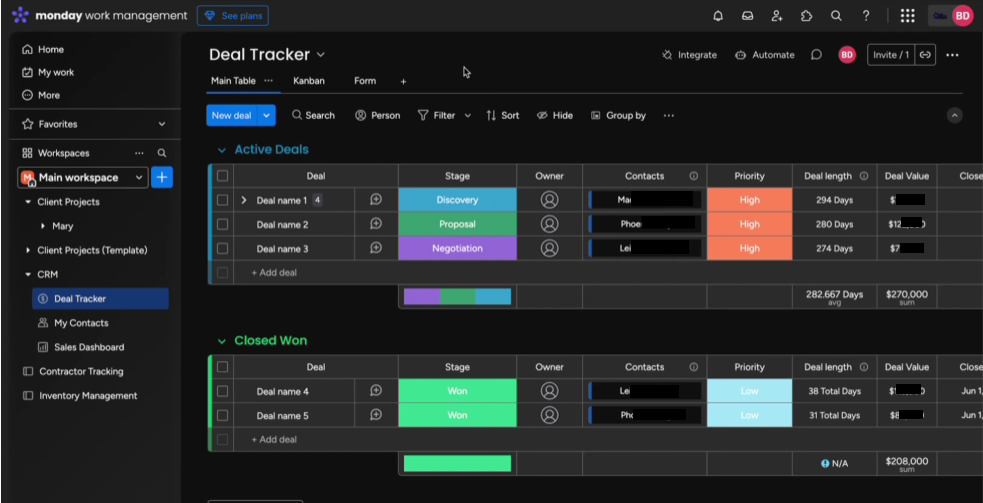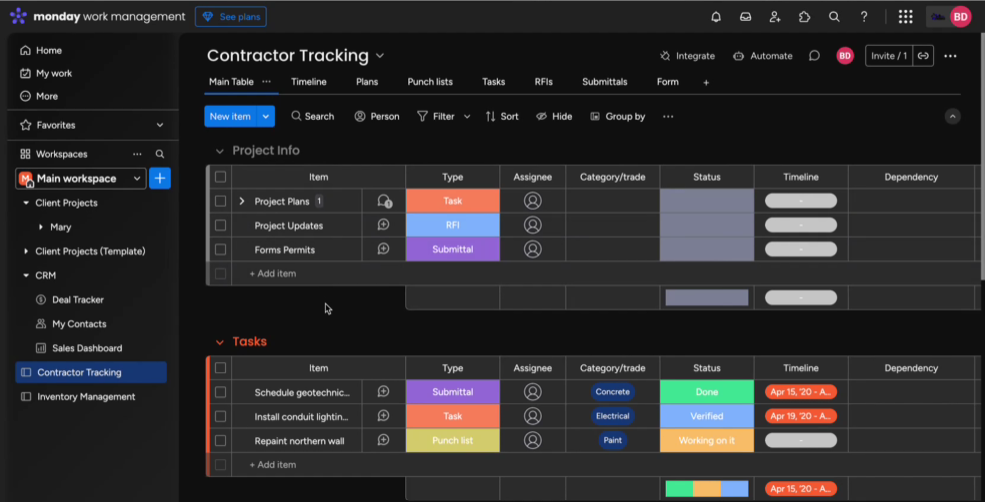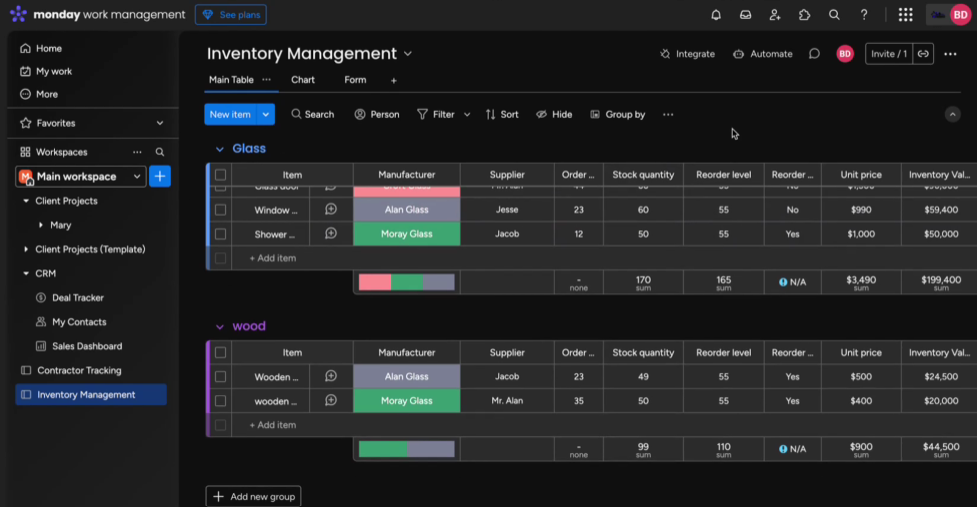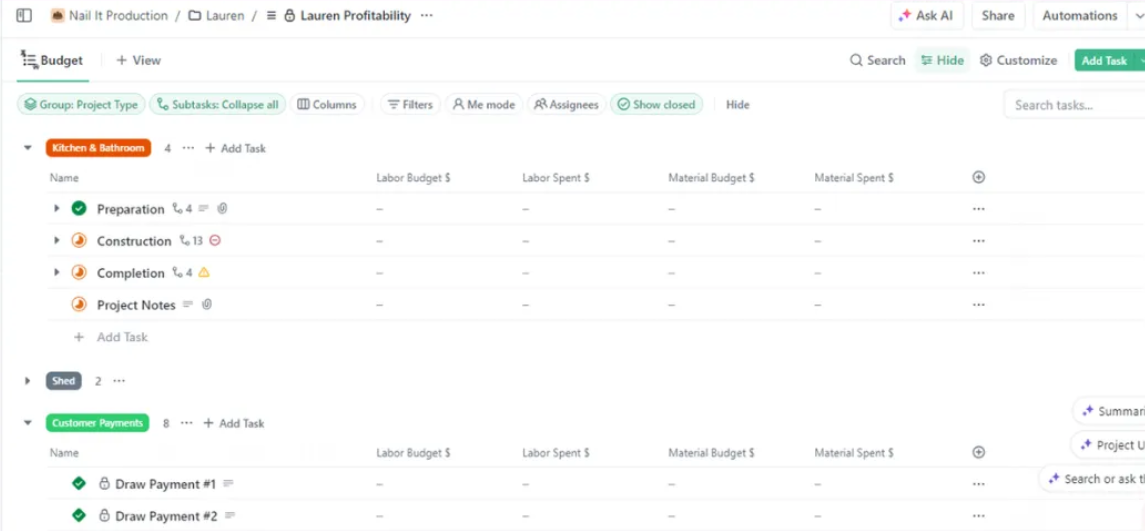Scaling a global clothing manufacturer is complex. Crease Group partnered with Camel Tech to implement custom systems and automation—transforming their operations and setting the foundation for scalable, end-to-end production.

How Nail It Upgraded Construction Management in 2 Phases
95%
Data Centralization
17hrs
Saved Weekly
100%
Project Visibility
Results Highlights:
-
One source of truth: 100% of project data consolidated into a single platform, eliminating information silos.
-
Real-time budget tracking: Full visibility into budgets and costs, preventing overruns and surprises.
-
Faster project delivery: Standardized templates and automated workflows accelerated project timelines (projects now finish 20% faster on average).
-
Zero missed inspections: New permit and inspection tracking system ensures compliance tasks are never overlooked.
-
Streamlined materials management: Automated inventory alerts eliminated last-minute material shortages, keeping job sites running smoothly.
-
Improved stakeholder communication: Shareable dashboards and reports sped up bank draw approvals and client updates, enhancing transparency.
Introduction
Nail It Construction is a Florida-based full-service remodeling company with over 40+ years of combined experience in the industry. Serving the greater Tampa Bay area, the company has built a reputation for reliability, gold-standard workmanship, and customer-first service. Despite successfully completing thousands of projects and earning the trust of homeowners, Nail It’s behind-the-scenes operations hadn’t kept pace with its growth. Project information was scattered across Google Sheets, Drive folders, and even other tools – making it difficult for their team to stay aligned. Critical details about budgets, permits, inspections, and inventory were siloed in different files or people’s heads, leading to inefficiencies that threatened to slow down their projects. In 2024, Nail It Construction recognized that to maintain their high standards and scale further, they needed to overhaul their construction management processes. They embarked on a two-phase digital transformation journey with ClickUp & Monday for construction management – a move that would revolutionize how their projects are planned, executed, and delivered.
Company Overview
Based in Tampa Bay, Florida, Nail It Construction is a licensed and insured general contractor specializing in full-service kitchen, bathroom, and home remodels. With over 40 years of combined team experience, the company has delivered hundreds of residential remodeling projects across Pinellas, Hillsborough, Pasco, and surrounding counties. Their team includes seasoned project managers, designers, and subcontractors known for professionalism, reliability, and top-tier workmanship.
Driven by a mission to treat customers like family, Nail It prides itself on exceptional craftsmanship, transparent communication, and seamless project execution. To scale their operations while preserving their high standards, they partnered with Camel Tech to modernize their construction management systems through a strategic digital transformation.
Location
Tampa Bay, Florida, USA
Use cases
Full SCALEable™ implementation
Industry
Residential Remodeling & Construction
Employees
10-40
Challenges
Like many growing construction firms, Nail It Construction faced several pain points in their project management workflow. These challenges were causing delays, errors, and frustration for the team:
-
Scattered data across multiple platforms:
Project information lived in disparate places—Google Sheets, Google Drive, email threads, and messaging apps like WhatsApp and Slack. There was no single source of truth. Team members wasted time hunting for the latest spreadsheet, document version, or approval message. Data was often duplicated, outdated, or missed entirely, leading to confusion and delays. -
Lack of budget visibility:
Budgets for labor, materials, and other costs were tracked in standalone spreadsheets with no real-time updates. Without a unified budget tracking system, it was hard to see if a project was overspending until it was too late. The leadership had little visibility into budget vs. actual costs in the moment, risking profit erosion. -
No centralized labor payment tracking:
Information related to labor payments—such as hours worked, payment status, due dates, and work scopes—was scattered across spreadsheets and chat threads. There was no unified system to track who had been paid or when payments were due, leading to confusion, last-minute follow-ups, and frequent delays in processing worker compensation. -
No material tracking or shipment status system:
The company lacked a structured way to track material orders or monitor shipment status. Details like order dates, delivery timelines, and supplier updates were managed informally through messages or emails. This led to on-site delays when materials hadn’t arrived as expected or were missing, often resulting in last-minute calls and urgent supply runs. -
Platform limitation in Monday.com:
The team initially implemented their system in Monday.com, but as operations grew and more Spanish-speaking team members were onboarded, the lack of native Spanish language support became a barrier. To ensure full team adoption and usability, they transitioned their entire workspace to ClickUp, which offered multilingual support and greater flexibility. -
No task dependencies or timeline view:
Project schedules were managed on basic calendars and spreadsheets with no dependency linking. If one task slipped, there was no automatic adjustment of subsequent tasks. Project managers lacked an easy way to visualize timelines or predict the impact of delays, leading to reactive firefighting rather than proactive planning. -
No visibility across project types (Kitchen, Bath, etc.):
Clients often requested different types of remodeling projects—like kitchens, bathrooms, or full-home renovations—but the team lacked a standardized system to manage and track these variations. There was no clear visibility into project types, phases, or status, making it hard to plan resources, maintain consistency, or report progress across similar scopes of work - Limited reporting & real-time insights:
Because data was everywhere, management couldn’t get quick answers to important questions like “What’s the status of Project X?”, “Are we on budget this month?”, or “How is our subcontractor crew performing?”. The team lacked dashboards or reports, meaning insights had to be gathered manually, if at all
“These pain points—bottlenecks in information, communication breakdowns, and process gaps—made it difficult for Nail It to scale their business and manage projects smoothly. They knew a change was necessary to modernize their operations and continue delivering top-notch service.” Enter Camel Tech.
Transformation with Camel Tech
To overcome operational bottlenecks and prepare for growth, Nail It Construction partnered with Camel Tech for a full-scale digital transformation. The journey began with Monday.com, but due to the platform’s lack of Spanish language support, the team later migrated to ClickUp. This two-phase approach allowed Nail It to streamline every layer of the business while ensuring full team adoption.
Phase 1: Structuring Operations and Client Workflows in Monday.com
1. Client project board:
We built a Client Projects board to track all active and upcoming remodeling jobs in one place. Each project entry captured key data such as client name, remodel type (kitchen, bath, etc.), scope, and start date. This high-level board gave Nail It’s leadership a centralized view to allocate resources, plan timelines, and avoid overlapping commitments—ensuring smoother handoffs between sales and operations.
2. Client project template (boards within boards):
To standardize project execution on Monday.com, we developed a comprehensive project template that can be duplicated for each new client project. Each project, once won, gets its own group of sub-boards or sections within Monday.com, covering all aspects of execution. 
3. CRM & sales pipeline board:
In tandem with project management, we implemented a CRM board on Monday.com to handle Nail It’s sales leads and client acquisition process. This board tracks each potential deal from initial inquiry through contract signing. We customized columns for lead source, deal value, stage (e.g., contact made, site visit scheduled, proposal sent, closed-won/lost), and next action. Coupled with this, we built a Sales Dashboard that pulls from the CRM board to show metrics like number of new leads, conversion rate, and revenue forecast. Nail It’s management can now get a quick read on their sales pipeline and identify where to focus to hit their growth targets.
4. Contractor tracking board:
We created a Contractor Tracker to manage contractor assignments, license details, and payment status. This board helped the team verify compliance, track on-site schedules, and oversee vendor performance—all from one unified view. Managers could easily confirm which contractors were active, what jobs they were on, and whether documentation was up to date.
5. Inventory management board:
To track materials, we built a visual inventory board listing items by category with current stock levels, reorder status, and delivery timelines. Color-coded status tags made it easy to identify items that were low or delayed. This visibility helped the team coordinate purchasing ahead of time and reduced the chance of material-related project delays. 
7. Dashboards & integrations:
We configured multiple dashboards to aggregate project and sales data. A Master Project Dashboard summarized active jobs, overdue tasks, and key blockers. A Sales & Projects Overview correlated pipeline performance with upcoming workload for smarter resource planning. We also integrated Google Drive and web forms so that leads, documents, and photos flowed directly into Monday.com boards.
Phase 2: Transition to ClickUp
While Monday.com brought much-needed structure, the platform’s lack of Spanish language support became a significant challenge for Nail It’s growing team. To support better adoption and accommodate Spanish-speaking staff, the entire Monday.com workspace was later migrated to ClickUp. This transition marked Phase 2 of the digital transformation—bringing deeper automation, multilingual support, and even more scalability.
1. Consolidating tools into ClickUp:
We migrated all project data from Google Sheets, Google Drive, email threads, and other fragmented tools into ClickUp. This involved creating a dedicated Construction Project Space that would serve as the single source of truth for all projects. Every active remodel—whether large or small—is now managed in ClickUp, eliminating the need to juggle multiple apps and manual updates.
2. Client project template:
Within this new space, we built a hierarchy of folders and lists mirroring Nail It’s actual workflow. Each project received its own folder with sub-lists for different phases or building components. We configured custom views—such as Table, Calendar, and Gantt timelines—and tailored statuses to suit construction project stages. Automations were implemented to handle routine updates, like automatically adjusting task statuses when completed or triggering timeline adjustments based on dependencies. These structured workflows helped standardize operations and minimize human error across projects.:
3. Budget tracking in real time:
To tackle the budget visibility issue, we implemented a comprehensive budget tracking list inside ClickUp. All budget items—such as labor, materials, and contractor costs—were tracked using custom fields for estimated vs. actual spend. We introduced roll-up widgets and formulas to calculate total project cost and added trigger alerts (e.g., if actual cost exceeds the budget threshold, the status changes or a notification is sent). Project managers and executives can now monitor financial performance in real time, without relying on manually updated spreadsheets.
Project managers and executives can now monitor financial performance in real time, without relying on manually updated spreadsheets.
4. Contractor payment tracking list:
Within the space, we added a centralized Contractor Payment List to manage all labor-related payments. Using ClickUp’s custom fields and forms, Nail It can log each contractor’s name, role, work scope, payment amount, and due date. We implemented automations such as triggering reminders when a payment due date is approaching and auto-closing tasks once payment is marked complete.  This system ensures timely compensation and eliminates missed or delayed contractor payments.
This system ensures timely compensation and eliminates missed or delayed contractor payments.
5. Material tracking and shipping status:
To streamline material coordination, we built a Material Tracker list in ClickUp, paired with update forms accessible via phone or tablet. Field teams or office staff can log material orders, expected delivery dates, and shipping status in real time. Key fields include material type, supplier, order date, delivery status, and tracking details. Automations flag delayed shipments or overdue deliveries, allowing the team to proactively follow up with vendors.![]() This system ensures that project sites stay informed about incoming materials and reduces delays caused by uncertain or missed deliveries.
This system ensures that project sites stay informed about incoming materials and reduces delays caused by uncertain or missed deliveries.
6. Dashboards for reporting:
Alongside the operational setup, we developed several ClickUp Dashboards to give Nail It’s leadership instant insights. These dashboards pull data from all projects and lists to display things like: overall project progress, tasks due this week, budget utilization by project, and material tracking alerts. Instead of manually assembling reports, managers now had a visual cockpit to monitor the health of all ongoing projects in real time. This addressed the previous lack of reporting – now trends and problem areas could be spotted at a glance.
This addressed the previous lack of reporting – now trends and problem areas could be spotted at a glance.
7. Scalable project templates:
To enforce best practices and speed up project planning, we created scalable templates for common project types. For example, a “Kitchen Remodel Template” list was developed, containing a pre-built set of tasks (with dependencies, durations, and assignments) covering everything from initial demo to final inspection. Similarly, templates for bathroom remodels and room additions were made. Now, when Nail It kicks off a new project, they can instantly spin up a structured project plan by importing the template – saving hours of setup time and ensuring nothing is forgotten. This templated approach brought consistency across projects, no matter which project manager was running it.
This templated approach brought consistency across projects, no matter which project manager was running it.
8. CRM & Growth space setup:
As part of the internal operations overhaul, we built a dedicated CRM space in ClickUp to centralize sales lead tracking and client acquisition efforts. The system allows the team to log incoming leads, assign follow-ups, and track each deal through custom pipeline stages—from inquiry to closed project. Key fields include lead source, project type, deal value, and follow-up status. Automations and dashboards give management real-time visibility into pipeline health, helping them prioritize high-value opportunities and reduce response delays. This CRM setup ensures no lead is missed and provides a structured workflow to convert more inquiries into signed projects.
This CRM setup ensures no lead is missed and provides a structured workflow to convert more inquiries into signed projects.
With Camel Tech leading the transition, Nail It Construction now runs on a unified, scalable system. From sales CRM and contractor payments to material tracking and project dashboards, every aspect of their construction management is streamlined. The result: faster execution, fewer delays, real-time visibility, and a business that’s ready to scale—without sacrificing the quality and reliability their clients know them for.
What We’ve Implemented – At a Glance
Camel Tech led a two-phase digital transformation for Nail It Construction, starting with Monday.com and later migrating to ClickUp to address language limitations and enhance system scalability. Here’s a quick summary of what we implemented:
Monday Implementation (Phase 1)
-
Planned projects board: A visual pipeline to track all ongoing and upcoming remodel jobs, helping allocate resources efficiently.
-
Client project template: Standardized project execution with structured boards for status, design, material, timeline, and financials.
-
CRM & sales dashboard: Full sales pipeline tracking from lead to contract, with conversion insights and lead management tools.
-
Contractor tracker: Centralized tracking of subcontractor assignments, compliance status, and payment progress.
-
Material tracking board: Visual material tracking board with order status and delivery timelines to avoid project delays.
-
Project templates: Ready-to-launch workflows for kitchen, bath, and other remodels
ClickUp Implementation (Phase 2)
-
Construction project space: Centralized workspace with folders and lists mirroring Nail It’s actual construction workflows.
-
Budget tracker: Real-time tracking of estimated vs. actual spend with alerts for overspending.
-
Contractor payment tracker: Logged labor payments with due dates, automation alerts, and completion status.
-
Material & shipping tracker: Monitored material orders and delivery status with real-time updates and delay alerts.
-
CRM & sales space: Built-in sales pipeline with lead tracking, status stages, and follow-up automations.
-
Dashboards & reports: Custom dashboards providing visibility into task progress, budgets, contractor performance, and delivery timelines.
-
Project templates: Scalable templates for common project types (kitchen, bath, full-home remodels).
- Training & SOP space: Hosted internal SOPs, system walkthroughs, and training documents for faster onboarding and knowledge sharing.
- Internal ops (Leadership, HR, Finance): Organized back-office processes into a dedicated space for improved team alignment.
Together, these tools eliminated manual processes, reduced delays, and created a scalable system for growth.
Results
After implementing both phases of their digital transformation, Nail It Construction experienced a significant improvement in efficiency, team alignment, and project delivery. The move from scattered tools to structured, centralized systems resolved key bottlenecks and laid a solid foundation for growth.
-
Centralized systems & clarity: Starting with Monday.com and evolving into ClickUp, Nail It transitioned from siloed spreadsheets and chat threads to an integrated digital workspace. All project, budget, material, and contractor data now lives in structured dashboards. This eliminated time wasted searching for updates and gave the team a single source of truth for decision-making.
-
15–20% faster project delivery: Standardized workflows, automation, and task dependencies in ClickUp help keep projects on track. Templates for remodel types (kitchen, bath, full-home) streamline kickoff and reduce planning time. Tasks move faster through each phase, and the team reports a consistent 15–20% improvement in overall project delivery speed.
-
Proactive material tracking: With real-time material tracking in ClickUp and Monday.com, the team now monitors delivery status, order updates, and vendor delays without relying on memory or messages. Automated alerts flag late shipments or items marked “on order,” helping the team avoid last-minute supply runs and keep projects running on schedule.
-
Proactive inventory management: Inventory is now tracked in real time across both ClickUp and Monday.com, with reorder triggers and material availability views.
Site managers and the office team stay in sync on stock levels, orders, and deliveries. As a result, last-minute supply runs are rare, and projects aren’t paused due to missing items. -
Real-time dashboards & reporting: Custom dashboards give leadership instant visibility into project progress, labor payments, and material logistics. Instead of pulling reports manually, department heads can open their dashboards to identify blockers, spot cost overruns early, and make data-driven decisions on the fly.
-
Structured sales & CRM tracking: ClickUp CRM system brought structure to Nail It’s sales pipeline—tracking leads, deal values, and client follow-ups from inquiry to contract. With a sales dashboard in place, management can forecast revenue, monitor conversions, and ensure every lead gets timely attention.
-
Faster, cleaner client communication: ClickUp supports shareable views that allow the team to send clients clear updates on project status, timelines, and material planning. This reduced the need for manual follow-ups and improved the client experience with faster responses and more professional reporting.
- A scalable, systemized operation: With reusable project templates, documented SOPs, and centralized workflows, Nail It is now built to grow. Onboarding new staff takes less time, and every project follows a consistent structure—regardless of who’s managing it. The business is no longer dependent on memory or one-off spreadsheets; it now runs on repeatable, scalable systems.
Nail It Construction transformed its operations through a two-phase digital overhaul—starting with Monday.com, which brought much-needed structure but lacked support for their Spanish-speaking team. To overcome that limitation and unlock greater automation and flexibility, Camel Tech transitioned their systems to ClickUp. What was once a fragmented, manual process is now a streamlined, multilingual, and automated operation—enabling faster project delivery, real-time visibility, and seamless team collaboration. With ClickUp powering their construction management, Nail It is now fully equipped to scale while maintaining the high standards their clients expect.
Related Success Stories
Scaling an accounting firm is no easy task. Camel Tech helped SDA CPA implement a ClickUp-powered system that transformed their operations—bringing structure, automation, and visibility to 85% of their workflows.
Scaling a home care service is complex. Serenity Pointe partnered with a Camel Tech to implement proven systems—transforming operations and enabling sustainable growth.
Build a business that thrives without you
Let's book a call with our expert.

